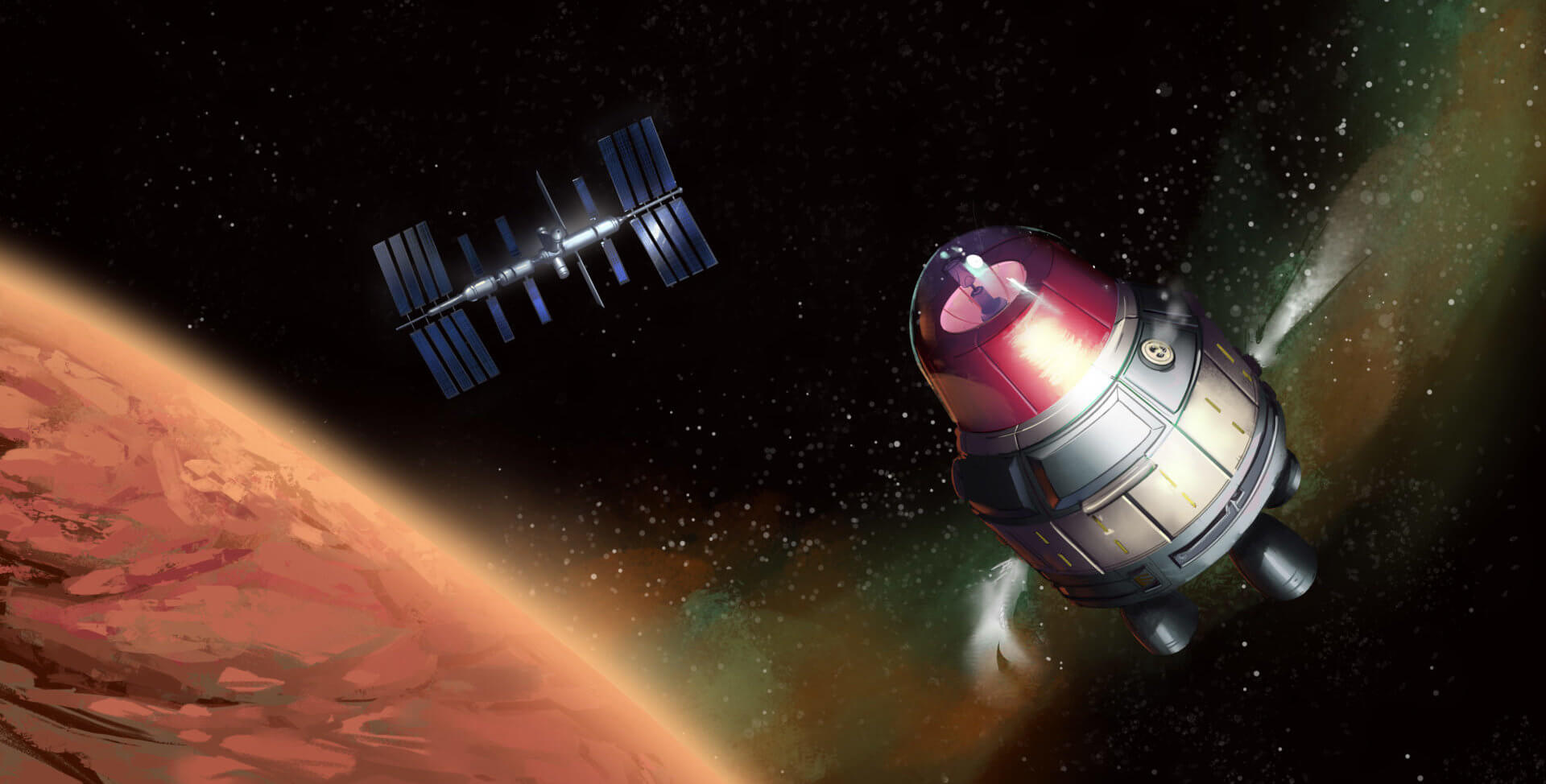Trojan Dreams and Many Worlds
A Crewed Mission to Mars?
USC students design a lighter, more adaptable vehicle to help make a crucial piece of a human mission to Mars—bringing astronauts home—possible
By Avni Shah
In 1971, David Bowie asked, “Is there life on Mars?” echoing the curiosity of people all over the world. Mars has long been a subject of wonder and, in practical terms, a pivotal part of the next chapter in space exploration.
NASA asked student teams to help propel it into this next chapter by solving a core problem: how to bring a two-person crew home from Mars. In response to the 2021 NASA RASC-AL challenge, a team of USC Viterbi students developed the MAVIC (Minimum Ascent Vehicle for Interplanetary Crew). The team was one of 16 finalists out of over 50 teams in the competition, which ended in June.
The project, advised by Anita Sengupta, adjunct associate professor of astronautics at USC Viterbi, prioritized reduction of mass as the key way to reduce entry, descent and landing challenges for the vehicle.
Jessica Yuan, co-lead of the MAVIC team and a mechanical engineering junior at USC Viterbi, explained, “The weight constraints pushed us to innovate away from previous designs for similar missions, which use heavyweight vehicles that hover around 40 tons for a crew of four.” The MAVIC is approximately 20 tons for a crew of two, with a dry mass of 4,976 kilograms and a wet mass of 16,976 kilograms.
To reduce mass, the team had to get creative. A lot of existing design elements were incorporated in new ways.
Yuan and co-lead Albert Sun, former USC undergraduate and currently a junior studying economics, math and physics at the University of Chicago, pointed to three pivotal aspects of their design that helped reduce the vehicle’s weight: a toroidal (doughnut-like) structure for the tank design to reduce the height of the vehicle; a propellant that can be stored at room temperature and does not require heavy temperature regulating equipment; and a single door (hatch) for entry and docking, versus using two of them.
The project is estimated to take 10 years to complete and cost $7 billion.
A crewed mission to Mars requires many pieces to come to fruition. Said Yuan: “The Mars ascent vehicle is a prerequisite for mission success.”
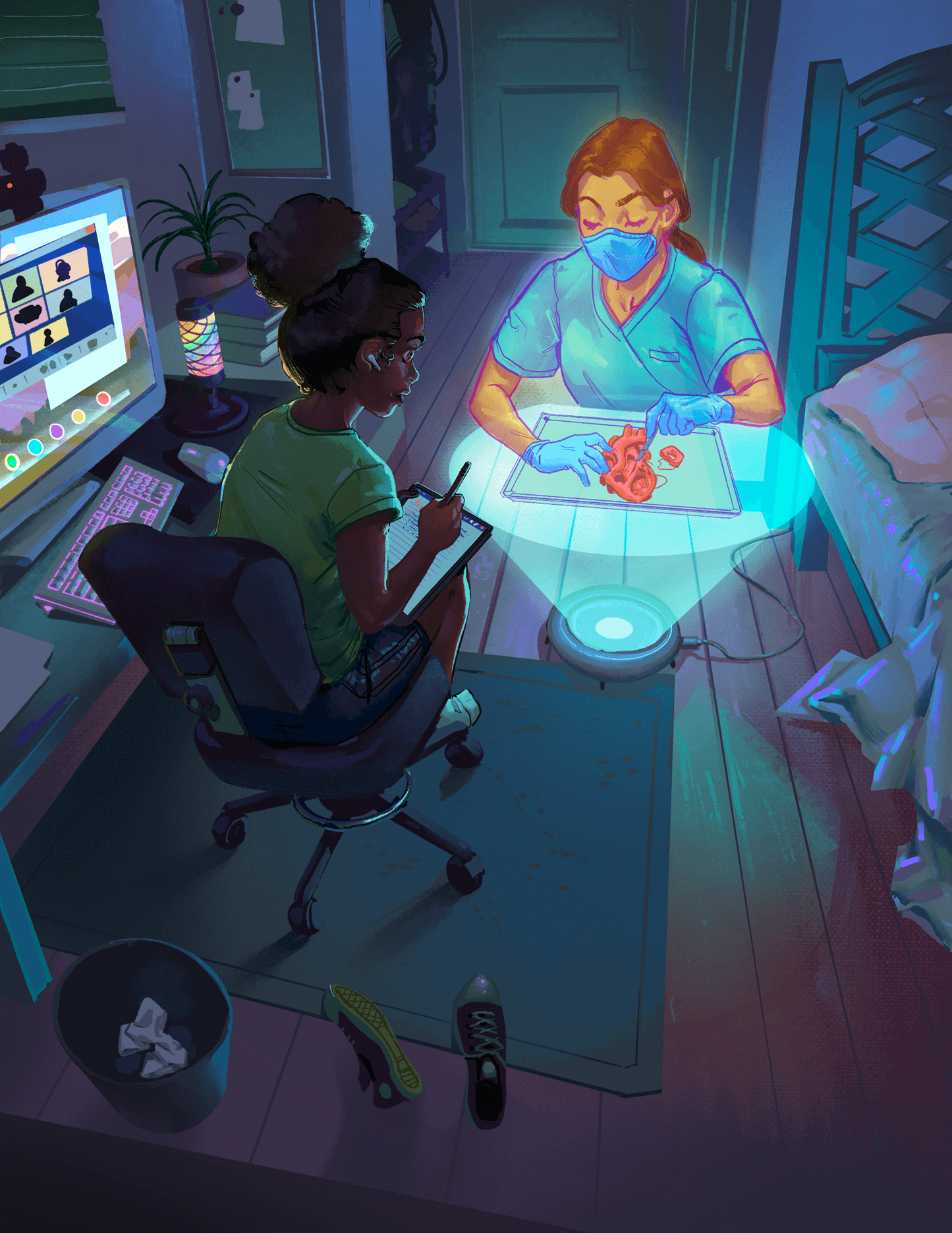
Charting a Course to 6G
Andy Molisch’s tests bring us closer to a holographic, haptic internet
By Benjamin Paul
Imagine you’re a fisherman living by a lake. Every day, you row out on the calm waters to catch fish. Life is good. But then your family grows and you need more fish, so you go to the river. You can go farther and faster on the river, but you can’t take your little rowboat out there — it’s not built for those currents. So you learn everything you can about how rivers work and build a better boat. Life is good again — until you realize you need more fish and need to go farther still, to the ocean. But ocean rules are nothing like river rules. Now you have to learn how ocean currents work and then design an even more advanced boat that can handle those conditions.
Communications frequencies are just like those currents, and the different boats are just like the tools we build to communicate. Before we can build the devices to create the next generation of communications, we have to understand the currents we’re working with. Andy Molisch, professor of electrical and computer engineering and the holder of the Solomon Golomb – Andrew and Erna Viterbi Chair, is doing just that for the next communications frontier: 6G.
Molisch’s highly detailed measurements of 6G frequencies, which were conducted along with postdoc Naveed Abbasi and several Ph.D. students, as well as undergraduate and master’s students, have yielded surprising results.
“Researchers have long believed that as we move up into 6G frequency, the ways in which a signal can reach a receiver will be greatly limited,” said Molisch. “Our work shows that that is not always the case.”
Think of his calculations as something like early explorers suddenly discovering the Gulf stream. With this new information, engineers can begin to design the tools necessary to make 6G a reality.
This, in turn, is an important step toward realizing a whole host of new applications. Molisch has identified three that he believes will be front and center: haptic (or touch) internet, mobile-edge computing, and holographic communications. All three of these have the potential to change the face not just of communications, but society as a whole.
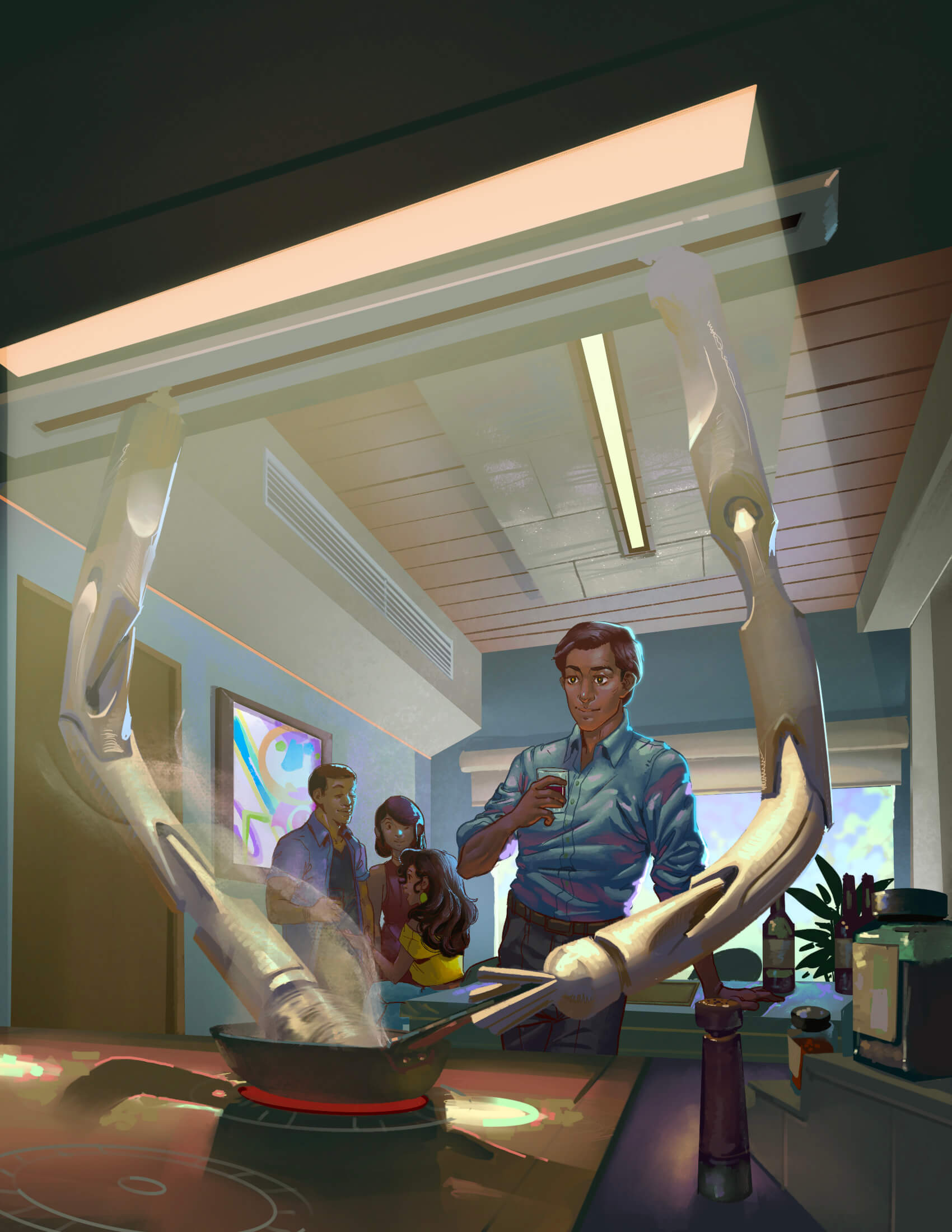
Bot Appetit
What’s on the menu tonight? This robot could be your future culinary companion.
By Caitlin Dawson
After a long day at work, an autonomous pod drops you off at your home, sweet home. Your fingerprint opens the door, as the scent of fresh garlic and tomatoes gently wafts toward you.
“What’s for dinner?” you call out. The answer: “On the menu tonight: spaghetti bolognese, with lemon tiramisu for dessert. This meal contains 63% of your recommended daily calories.”
Your chef is a robot that honed its culinary skills by watching YouTube cooking videos, using technology developed by Stefanos Nikolaidis, a USC Viterbi assistant professor of computer science.
“If humans can learn to make pancakes by watching videos, why can’t robots?” Nikolaidis asked.
Cooking is complex in terms of manipulation, the steps involved and the tools used. To cut an apple, for example, you need to take a knife, put it in the right place, make the cut and view the results to make sure you did them correctly.
Early attempts to “teach” robots focused largely on pre-programmed instructions. That led to countless culinary disasters in real-world kitchens. With the robots confused by clutter, and failing to recognize the difference between utensils in unexpected places, people came home to more mashed bowls than mashed potatoes.
Instead, by watching videos on the internet and observing what others do, Nikolaidis’s robots are learning complicated grasping and manipulation motions, and recognizing which tool to use for a given action—for instance, a spatula to turn food in a pan, a knife to cut chicken.
Your robot chef uses several key systems: computer vision to “see” the objects, artificial intelligence to process that information and language parsing to help it understand spoken commands.
Since its deployment, the robot chef has learned different cooking styles from cultures all over the world and even adapted its recipe repertoire based on the user’s preference. Nikolaidis’s top request to his autonomous robot chef? “That’s easy,” he said. “Ramen.”
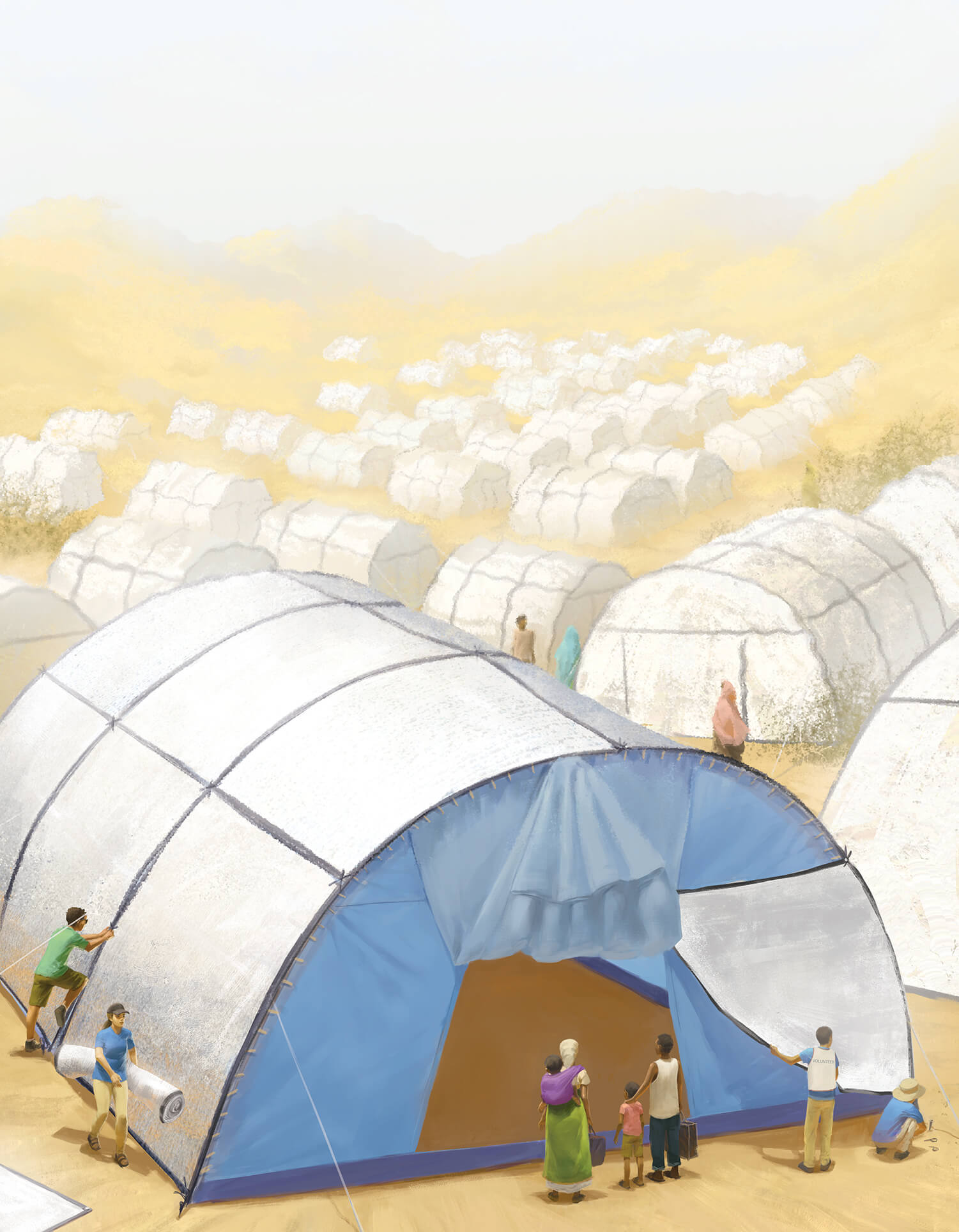
A Torch Kept Lit
Jacob Totaro, B.S. C.E.E. ’21, created a product to make temporary shelters more livable
By Daniel Druhora
Seven hundred people experiencing homelessness die from hypothermia each year in the United States, according to the National Coalition for the Homeless. Even in sunny Los Angeles, more unsheltered people have died from the cold in the past five years than in New York City and San Francisco combined. As a USC Viterbi environmental engineering major, Jacob Totaro learned about an increase in weather-related deaths in places experiencing rapid changes in climate, as well as an alarming new wave of climate refugees.
The numbers inspired Totaro to action. In February 2020, before COVID-19 was declared a pandemic, Totaro and a team of students enrolled in the class “Innovation in Engineering and Design for Global Challenges” traveled to Europe’s largest refugee camp, Moria, on the Greek island of Lesvos, then home to 30,000 refugees living in tents and makeshift shelters. Sponsored by USC Viterbi School of Engineering, the team volunteered and conducted research in the camp for over a week. Out of the myriad of problems facing the refugee population, they discovered that people were dying due to lack of proper insulation in shelters, especially in the winter.
Return to USC they went to work on a solution, experimenting with new materials. They arrived at Aluminet — a special knitted screen material of metalized polymer used in industrial greenhouses — Totaro’s team designed an insulated tent cover, called a Torch Tile, that reflects outside heat while using body heat to thermoregulate the interior. The result is a shelter that bounces heat back on hot summer days and cools the shelter, yet can increase temperatures inside by as much as 50 degrees Fahrenheit when it’s the cold. The material is breathable enough to allow airflow, reducing humidity inside tents by 5% to 10%. Torch tiles are also ultra-adaptable: they stretch to fit the available space, and their geometric design makes them easy to repair or replace.
After eight months of prototyping and 36 iterations, Totaro’s team returned to Moria in February 2020, to test their product. They ran out of Torch tiles within a day due to high demand from refugees.
Totaro realized that what they were working on for the refugee crisis could be applied to the homelessness crisis in their own backyard. He began a campaign to distribute 2,000 Torches throughout L.A.’s Skid Row by the end of 2020. He and his teammates also sent Torches free of charge to Las Vegas; Long Island, New York; San Francisco; and to the U.S.-Mexico border – places where the students had access and organizational partners to work directly with the homeless population. In all, more than 3,000 tents have been made more livable by Torch Global Inc. as of this writing. They even created a campaign that allows campers to buy a Torch tile and give it to a refugee or a person experiencing homelessness.
Torch Inc. has since become a community action group whose goal is to distribute Torches all over the world and to grow a network of young innovators whose mission is to develop innovative solutions that improve the lives of people living in temporary shelters.
“Torch taught us that life-improving, sometimes lifesaving, products don’t need to be revolutionary,” Totaro said. “You don’t need to reinvent the wheel to help people.”
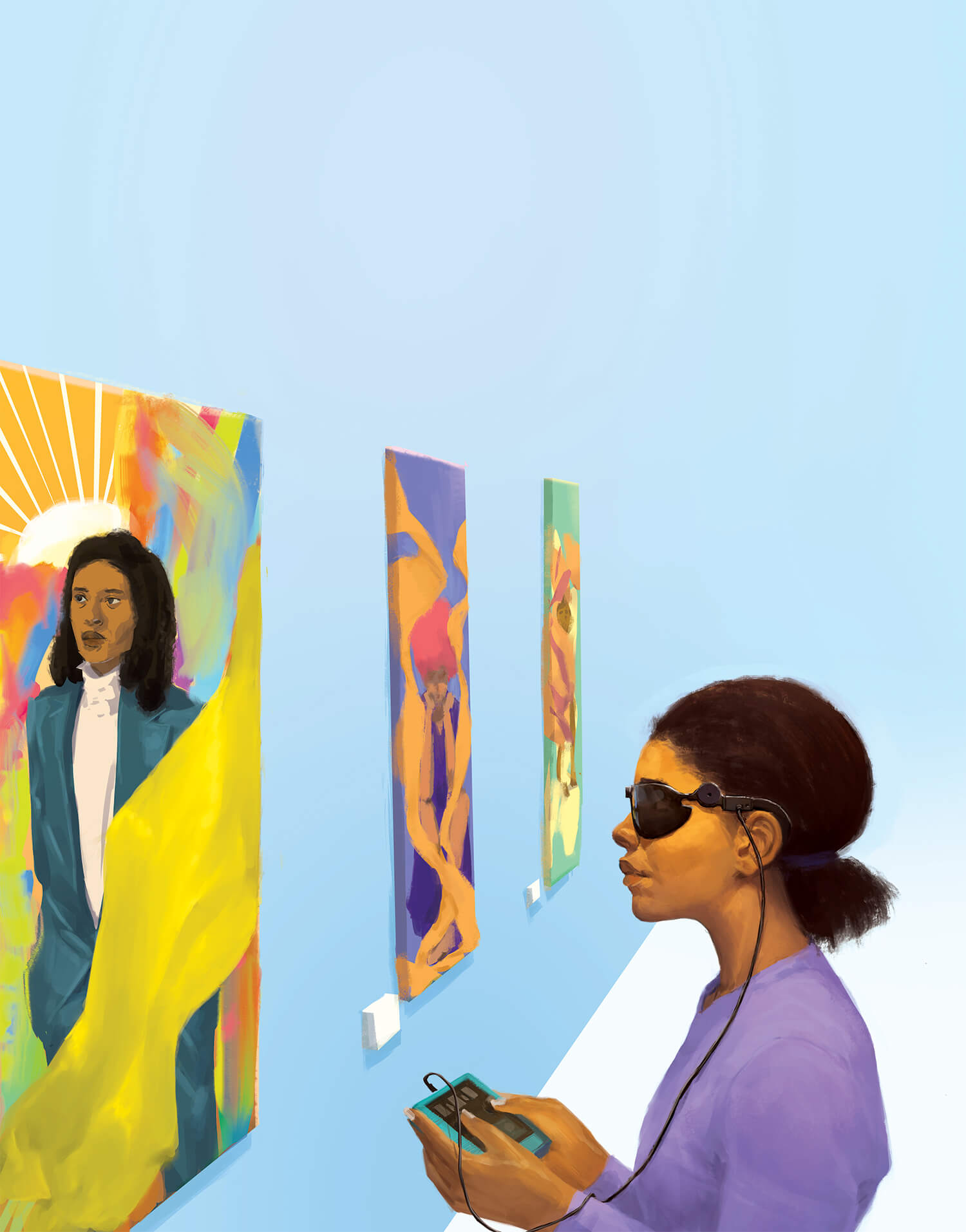
A Light (and Colors) At The End Of The Tunnel
USC researchers are using supercomputers to restore partial vision to people with blindness.
By Cheyenne Gaima
In 2013, the Argus II artificial retina became the first FDA approved device to restore sight to the blind.
When light enters the eye, photoreceptors translate the light into electrical pulses that are sent to your brain through the optic nerve. The Argus II replaces light by stimulating the cells with electrical pulses directly.
Developed over 25 years by Professor Mark Humayun — an ophthalmologist turned biomedical engineer whose grandmother had lost her sight to diabetic retinopathy — the device has since helped hundreds of people with degenerative eye diseases partially see again.
Meanwhile, researchers at USC, including Humayun and Professor Gianluca Lazzi, have been diligently making progress in their studies of retina prosthesis in the hopes of making potential products like the Argus II even better.
Lazzi, Provost Professor of Ophthalmology and Electrical Engineering at USC Viterbi and the Keck School of Medicine at USC, and his research team are currently working toward a major advancement.
“Our goal now is to develop efficient biomimetic systems that more precisely mimic the complexities and behaviors of natural neurological cells,” said Lazzi, who collaborated with Humayun on the original artificial retina research.
Lazzi and his team made progress using advanced computational modeling strategies that can run on supercomputers and replicate what happens in the retina to offer an increased understanding of the neural system. The revelation: color perception is a function of waveform and frequency of electrical stimulation.
This next generation of visual prosthetics would offer patients a step up from recognizing shapes and movements to perceiving colors and patterns, and with higher definition. The effects of these discoveries were already confirmed in patients in clinical trials, where subjects perceived chromatic colors along or nearby the blue-yellow axis in color space.
“Providing different colors—even limited—could greatly enhance vision,” said Lazzi. “Even if the vision is still resorting to the same number of pixels, the artificial retina system could detect certain image features, like an image or a door, and differentiate them by color to help a patient identify important features of the image.”
There are even discussions of adding artificial intelligence to the artificial retina for automated aid in feature recognition.
“My fascination with the fact that the human body is electrical in nature has grown over time,” Lazzi said. “The better we understand the electrical signals of the retina, the closer we will be to truly bringing sight to the blind.”




